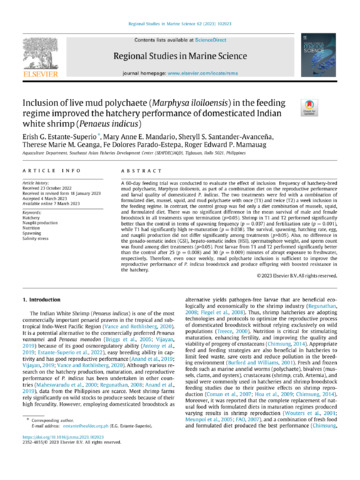Evaluation of maturation promoting factor in polychaete (Marphysa sp.) on Indian white prawn, Penaeus indicus female broodstock
- Global styles
- MLA
- Vancouver
- Elsevier - Harvard
- APA
- Help

View/
Date
2022-07-15Author
Page views
756ASFA keyword
AGROVOC keyword
Taxonomic term
Metadata
Show full item record
Share
Abstract
Polychaete is considered the best maturation diet for penaeids; however, fluctuating supply and quality warrant detailed studies to understand the specific maturation-promoting factors present in polychaete. Indian white prawn, Penaeus indicus, was fed diets supplemented with different fractions of Marphysa sp. extracts. Fractions, such as the total soluble fraction (TSF), neutral lipid fraction (NLF), and polar lipid fraction (PLF), were incorporated in the maturation diet at 0.25, 0.50, and 1.00% following a 3 × 3 factorial design. One group was fed with basal diet (BD), and another was fed with fresh squid, mussel, and polychaete, serving as the control. After a 30-day feeding trial, results showed that the inclusion of polychaete extracts in the diet significantly improved P. indicus maturation compared to groups fed BD and control with 40% maturation rates (MR) (p = 3.4 × 10−4). MR was optimum in groups receiving diets supplemented with ≥0.5% TSF (70.00% ± 0.00) and NLF (60.00% ± 5.77). Similar improved MR was achieved in treatments receiving ≥0.25% PLF supplementation (60% ± 0.00). Accordingly, relative expression of ovarian vitellogenin mRNA of broodstock fed under 0.25 and 0.50% PLF group was 4.44 and 3.96 folds higher than BD, respectively (p = 0.003). No significant differences were detected in the broodstock survival, latency period, hepatosomatic, and gonadosomatic indices. Biochemical content analyses showed no significant differences among the nine treatments except for broodstock's higher ovary protein content in the TSF group (p = 0.037). This study highlights PLF as the most potent component of the polychaete extract in promoting gonad maturation in P. indicus maturation supplemented at a 0.25% optimum inclusion level.
Keywords
female maturation Marphysa sp. Penaeus indicus polychaete extracts vitellogenin mRNA expression PolychaeteSuggested Citation
Santander-Avancena, S., Traifalgar, R. F., Monteclaro, H., Castellano, J. L. A., Cordero, C., Laureta, L. V., & Quinitio, G. (2022). Evaluation of maturation promoting factor in polychaete (Marphysa sp.) on Indian white prawn, Penaeus indicus female broodstock. Aquaculture Research , 53(15), 5195-5204. https://doi.org/10.1111/are.16003
Type
ArticleISSN
1355-557X; 1365-2109Collections
- Journal Articles [1258]
Related items
Showing items related by title, author, creator and subject.
-
Reproductive quality evaluation of male Indian white prawn Penaeus indicus broodstock-fed diets supplemented with polychaete extracts (Marphysa sp.)
Santander-Avancena, Sheryll ; Traifalgar, rex Ferdinand
; Traifalgar, rex Ferdinand  ; Estante-Superio, Erish
; Estante-Superio, Erish  ; Janagap, Steve P.; Mamauag, Roger Edward
; Janagap, Steve P.; Mamauag, Roger Edward  ; Monteclaro, Harold
; Monteclaro, Harold  ; Laureta, Liberato V.; Quinitio, Gerald
; Laureta, Liberato V.; Quinitio, Gerald  (Taylor and Francis, 2023-06-23)
The present study determined the effect of different polychaete extracts, namely, total soluble fraction (TSF), neutral lipid fraction (NLF) and polar lipid fraction (PLF), in the maturation and sperm quality of male ...
(Taylor and Francis, 2023-06-23)
The present study determined the effect of different polychaete extracts, namely, total soluble fraction (TSF), neutral lipid fraction (NLF) and polar lipid fraction (PLF), in the maturation and sperm quality of male ... -
Inclusion of live mud polychaete (Marphysa iloiloensis) in the feeding regime improved the hatchery performance of domesticated Indian white shrimp (Penaeus indicus)
Estante-Superio, Erish ; Mandario, Mary Anne
; Mandario, Mary Anne  ; Santander-Avancena, Sheryll
; Santander-Avancena, Sheryll  ; Geanga, Therese Marie M.; Estepa, Fe Dolores
; Geanga, Therese Marie M.; Estepa, Fe Dolores  ; Mamauag, Roger Edward
; Mamauag, Roger Edward  (Elsevier, 2023-03-07)
A 60-day feeding trial was conducted to evaluate the effect of inclusion frequency of hatchery-bred mud polychaete, Marphysa iloiloensis, as part of a combination diet on the reproductive performance and larval quality of ...
(Elsevier, 2023-03-07)
A 60-day feeding trial was conducted to evaluate the effect of inclusion frequency of hatchery-bred mud polychaete, Marphysa iloiloensis, as part of a combination diet on the reproductive performance and larval quality of ... -
Nutritional strategies for efficient reproductive performance of captive Indian white prawn, Penaeus indicus (H. Milne Edwards, 1837)
Broodstock nutrition in penaeid is a vital component of a successful hatchery operation, however, there are still gaps in our present understanding of the nutrient requirements and strategies to optimize successful seed ...




